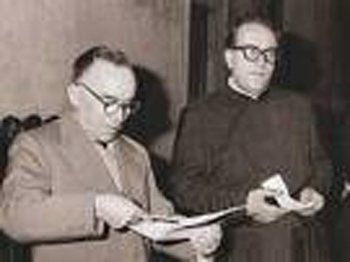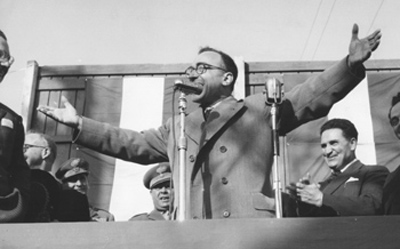Socio-Political Issues
 |
 |
 |
 |
 |
 |
 |
La Pira: A Catholic Communist - Part X
An Aggressive Enemy of Private Property
As we have seen in the previous article, business owners in Florence had reason to be alarmed by La Pira’s collusion with communists in his radical agenda to kill private enterprise and to make workers increasingly dependent on the State. Now we shall see how he continued eating away at the foundation of private property by moving seamlessly from persecuting the “employer class” to attacking that other bugbear of socialists: the “landlord class.”
In Florence of the 1950s, owners of more than one house or even spare rooms became an easy target for requisitioning purposes on behalf of the poor. In La Pira’s view (influenced by the Code of Camadoli, which he helped to create), such properties were considered surplus to requirements and liable to expropriation for the “common good.” Just as he called for employers to be sacked for laying off workers, so he regarded real estate investors as the “villains” to be punished for making profits from their own properties.
Property and plunder
 In fact, no property, large or small, public or private, was safe under La Pira’s administration. Giulio Andreotti, former Prime Minister of Italy, recalled that when he was Minister of the Interior in the 1950s, he had to send in the police to prevent La Pira from requisitioning the tax offices to house the homeless. (1) La Pira even gave the Deputy Mayor’s coat to the poor, telling him “You can buy another one!” (2) His friend and supporter, Archbishop Dalla Costa of Florence, evidently approved of the theft as the application of “the Gospel's word: ‘he who has two mantles, should give one of them to those who have none.’ ”
In fact, no property, large or small, public or private, was safe under La Pira’s administration. Giulio Andreotti, former Prime Minister of Italy, recalled that when he was Minister of the Interior in the 1950s, he had to send in the police to prevent La Pira from requisitioning the tax offices to house the homeless. (1) La Pira even gave the Deputy Mayor’s coat to the poor, telling him “You can buy another one!” (2) His friend and supporter, Archbishop Dalla Costa of Florence, evidently approved of the theft as the application of “the Gospel's word: ‘he who has two mantles, should give one of them to those who have none.’ ”
Unsurprisingly, La Pira exhibited exactly the same mentality in February 1953, when he issued an order in his capacity as Mayor of Florence to requisition privately owned houses – with immediate effect and without compensation – and gave them to the poor. For this he earned the undying admiration of the Catholic Communist, Dorothy Day, who later visited him and praised what she termed his “direct action” (Catholic Worker, October 1963) – a watchword among anarchists for radical social change that by-passes the rule of law.
Was his requisitioning of homes justified in Catholic teaching?
It is true that there were poor and homeless people in Florence and that the Church teaches that in extreme cases where there is lack of basic necessities such as food, shelter or clothing to sustain life the needy can legitimately take these things from those who have in abundance. One is not, however, entitled to take these necessities if they could be provided through one’s own work or through the voluntary assistance of others, whether municipal agencies or private charities. Not all of these avenues were considered by La Pira before proceeding to his ad hoc action.
When faced with a national emergency, such as the results of wartime bombing, governments are empowered to requisition unoccupied private homes for short-term lease to the homeless and pay due compensation to the owners. But La Pira’s initiative came in 1953 at the peak of Italy’s postwar reconstruction program, which was well on the way to alleviating the nation’s housing problem. As Minister of Labor (1947-1948 and again from 1948-1950), Fanfani developed the “Fanfani house” program for low-cost government-built workers’ homes, which were partly subsidized by employers’ contributions – a fact unacknowledged by La Pira.
 It is evident that the housing situation in Florence, though meriting serious concern, did not call for the enactment of requisition laws applicable in “large scale national emergencies” as Giampaolo Meucci, one of the La Pira’s supporters claimed. It was La Pira’s short-sighted policy of rent controls to keep rents well below the market value that contributed to the housing shortage in Florence. It meant that landlords could not make an adequate profit and were driven from the housing market. La Pira then made them out to be heartless tyrants for evicting their tenants. By setting tenant against landlord, La Pira fanned the flames of social hatred and class struggle. He thus made it easy for people to believe that private owners deserve to be punished by having their properties taken from them and given to the poor.
It is evident that the housing situation in Florence, though meriting serious concern, did not call for the enactment of requisition laws applicable in “large scale national emergencies” as Giampaolo Meucci, one of the La Pira’s supporters claimed. It was La Pira’s short-sighted policy of rent controls to keep rents well below the market value that contributed to the housing shortage in Florence. It meant that landlords could not make an adequate profit and were driven from the housing market. La Pira then made them out to be heartless tyrants for evicting their tenants. By setting tenant against landlord, La Pira fanned the flames of social hatred and class struggle. He thus made it easy for people to believe that private owners deserve to be punished by having their properties taken from them and given to the poor.
La Pira the anarchist
La Pira once described himself as an “anarchist, subject only to God,” and went on to explain what he meant by this: that he enjoyed “total freedom” and “permanent exemption” from obeying the laws of the land because they represented not justice but “forms of oppression” of the poor through “the inequalities that are hidden under the veils of the law.”
In true Liberation Theology fashion, he saw his mission as freeing the workers and the poor from the “exploitation” of the rich and powerful, taking his cue directly from his own interpretation of the Gospels. But by setting up a false dichotomy between “human rights” and property rights, La Pira was able to violate property instead of protecting it.
Was La Pira’s requisitioning policy legal?
La Pira’s interpretation of the law was based on a particular ideology and as such cannot be said to be objective. Time Magazine (August 13, 1956) was correct in noting La Pira’s “cheerful disregard for legality.” This was confirmed by Dorothy Day after her interview with La Pira when she reported that in his requisition of houses the jolly Mayor had been “bending the law to suit his purposes.” (Catholic Worker, May 1966) He often scorned the law not so much to help the poor but, crucially, to harm the interests of the rich. Thus he felt justified in doing what ordinary citizens could not do without committing a crime: taking by force the property that does not belong to them.
 His supporters state that he dusted off an old regulation of 1865, which allowed requisitioning of houses and applied it to the situation in Florence. But this raises more questions than it answers. Why should La Pira resort to an outdated law (3) when he had at his disposal Article 835 of the Civil Code of 1942, which allowed the requisition of property?
His supporters state that he dusted off an old regulation of 1865, which allowed requisitioning of houses and applied it to the situation in Florence. But this raises more questions than it answers. Why should La Pira resort to an outdated law (3) when he had at his disposal Article 835 of the Civil Code of 1942, which allowed the requisition of property?
If we examine the historical background of the 1865 regulation, it will become clear that it had no relevance to La Pira’s day. 1865 was the year in which King Victor Emmanuel arrived in Florence to make the city the capital of Italy (4) and the seat of the national government. Along with the Court came so many thousands of government functionaries and their families that a sudden housing shortage occurred and a law was hurriedly passed to requisition properties.
But this law was only the beginning of more sweeping State encroachments that would extend to Church property. The Minister of Justice and Ecclesiastical Affairs, Guiseppe Vacca, used it for the abolition of convents and monasteries: from 1869, all ecclesiastical property and funds were confiscated and requisitioned for the use of the State. (5)
When we consider that it was La Pira’s friend and colleague, the Marxist lawyer Giampaolo Meucci, (6) who suggested that he should use the 1865 regulation, it becomes clear that the object of La Pira’s Orwellian diktat was simply to place the law on the side of Socialism.
Continued

Posted August 14, 2013
In Florence of the 1950s, owners of more than one house or even spare rooms became an easy target for requisitioning purposes on behalf of the poor. In La Pira’s view (influenced by the Code of Camadoli, which he helped to create), such properties were considered surplus to requirements and liable to expropriation for the “common good.” Just as he called for employers to be sacked for laying off workers, so he regarded real estate investors as the “villains” to be punished for making profits from their own properties.
Property and plunder

Under the pretext of helping the poor
La Pira promoted Socialism
Unsurprisingly, La Pira exhibited exactly the same mentality in February 1953, when he issued an order in his capacity as Mayor of Florence to requisition privately owned houses – with immediate effect and without compensation – and gave them to the poor. For this he earned the undying admiration of the Catholic Communist, Dorothy Day, who later visited him and praised what she termed his “direct action” (Catholic Worker, October 1963) – a watchword among anarchists for radical social change that by-passes the rule of law.
Was his requisitioning of homes justified in Catholic teaching?
It is true that there were poor and homeless people in Florence and that the Church teaches that in extreme cases where there is lack of basic necessities such as food, shelter or clothing to sustain life the needy can legitimately take these things from those who have in abundance. One is not, however, entitled to take these necessities if they could be provided through one’s own work or through the voluntary assistance of others, whether municipal agencies or private charities. Not all of these avenues were considered by La Pira before proceeding to his ad hoc action.
When faced with a national emergency, such as the results of wartime bombing, governments are empowered to requisition unoccupied private homes for short-term lease to the homeless and pay due compensation to the owners. But La Pira’s initiative came in 1953 at the peak of Italy’s postwar reconstruction program, which was well on the way to alleviating the nation’s housing problem. As Minister of Labor (1947-1948 and again from 1948-1950), Fanfani developed the “Fanfani house” program for low-cost government-built workers’ homes, which were partly subsidized by employers’ contributions – a fact unacknowledged by La Pira.

Marxist friend Meucci, at right, brought up to La Pira an outdated law to expropriate renting houses
La Pira the anarchist
La Pira once described himself as an “anarchist, subject only to God,” and went on to explain what he meant by this: that he enjoyed “total freedom” and “permanent exemption” from obeying the laws of the land because they represented not justice but “forms of oppression” of the poor through “the inequalities that are hidden under the veils of the law.”
In true Liberation Theology fashion, he saw his mission as freeing the workers and the poor from the “exploitation” of the rich and powerful, taking his cue directly from his own interpretation of the Gospels. But by setting up a false dichotomy between “human rights” and property rights, La Pira was able to violate property instead of protecting it.
Was La Pira’s requisitioning policy legal?
La Pira’s interpretation of the law was based on a particular ideology and as such cannot be said to be objective. Time Magazine (August 13, 1956) was correct in noting La Pira’s “cheerful disregard for legality.” This was confirmed by Dorothy Day after her interview with La Pira when she reported that in his requisition of houses the jolly Mayor had been “bending the law to suit his purposes.” (Catholic Worker, May 1966) He often scorned the law not so much to help the poor but, crucially, to harm the interests of the rich. Thus he felt justified in doing what ordinary citizens could not do without committing a crime: taking by force the property that does not belong to them.

La Pira: A demagogue misreading Catholic doctrine to spread the socialist agenda of the Montini's group
If we examine the historical background of the 1865 regulation, it will become clear that it had no relevance to La Pira’s day. 1865 was the year in which King Victor Emmanuel arrived in Florence to make the city the capital of Italy (4) and the seat of the national government. Along with the Court came so many thousands of government functionaries and their families that a sudden housing shortage occurred and a law was hurriedly passed to requisition properties.
But this law was only the beginning of more sweeping State encroachments that would extend to Church property. The Minister of Justice and Ecclesiastical Affairs, Guiseppe Vacca, used it for the abolition of convents and monasteries: from 1869, all ecclesiastical property and funds were confiscated and requisitioned for the use of the State. (5)
When we consider that it was La Pira’s friend and colleague, the Marxist lawyer Giampaolo Meucci, (6) who suggested that he should use the 1865 regulation, it becomes clear that the object of La Pira’s Orwellian diktat was simply to place the law on the side of Socialism.
Continued
- Giulio Andreotti, “The extraordinary La Pira,” 30 Days, February 2004. Andreotti was Minister of the Interior in the 1950s;
- Douglas Hyde, ‘Hurricane Mayor,’ Catholic Herald, 15 July 1955;
- The Civil Code of 1942 had specifically abrogated the 1865 Civil Code;
- It was only in 1871 that the Italian capital moved to Rome. Before 1865, Turin was the capital city;
- For a detailed account of this little known historical event, see Patrick Keyes O’Clery, The Making of Italy 1856-1870, London Kegan Paul, Trench, Trubner & Co., London, 1892;
- As President of the Juvenile Court in Florence, Meucci presented the young as victims of a bourgeois culture that did not “understand” their needs. He revolutionized the Italian legal system by adapting it to the outlook of young offenders rather than making them conform to the law.

Posted August 14, 2013
______________________
______________________











